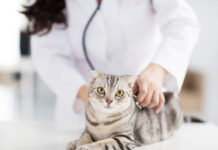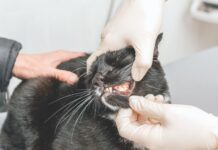Q.Our 5-year-old male tabby cat has begun grooming and biting himself incessantly to the point where the fur on his front legs and belly has thinned, and he is almost bald in these areas. Our efforts to stop him have not been successful, as we cannot watch him all the time. He acts normal otherwise, and his appetite is good. He is an indoor cat, so we don’t think he has fleas and have not seen any evidence of this. Can you help so that we can provide some relief to our little man?
A. I’m sorry to hear about your kitty’s problem. Cats normally spend a great deal of their time grooming …. as much as 50 percent of their waking hours. This grooming is believed to serve many purposes, from cleaning their coats to heat regulation and waterproofing their fur. When cats spend excessive time grooming, however, and/or when they groom to the point where they damage their fur, something may be amiss, and a visit to the veterinarian is warranted.
Many things can cause a cat to excessively or destructively groom, including behavioral issues, such as boredom and stress, and medical conditions, such as hyperthyroidism and obesity. The behavior can also be an indication of itchiness due to an allergy. In fact, allergies were the most common cause of skin disease in cats in a recent study by dermatologists at the Cornell University College of Veterinary Medicine.
Determining the cause of itchiness can be challenging. I know that you don’t see fleas, but your veterinarian will make sure that your kitty does not have any ectoparasites (parasites living outside the body), such as fleas, lice, mites or ticks. They can cause cats to lick and bite their fur either because they’re trying to remove them, or the parasites induce an allergic response (usually to the parasite’s saliva) when they bite the cat.
Allergies to flea bites are quite common in cats. They may also become allergic to endoparasites (those that live within the body) such as intestinal parasites.
Another common cause is food allergy. Cats can become allergic to compounds, most commonly proteins, in their diet. Diagnosis involves using a diet composed of ingredients that a cat has not been exposed to before (a novel diet). The rationale is that if a cat has never been exposed to a compound, he cannot have an allergic response to it. Novel diet trials require that the cat get only that diet for at least 12 weeks.
Common allergens in cat food include beef, lamb, soy, dairy products and wheat gluten. Trials of foods composed of both novel proteins and carbohydrates, such as duck and potato, may be attempted once other potential sources of allergy have been ruled out.
A third common cause of allergies in cats is atopy, or allergy to inhaled allergens. Like people, cats can become allergic to dust mites, pollens and molds. In some cases, atopy may be a seasonal syndrome (i.e., in spring when grass pollen is abundant).
In any case, a thorough history is an important in the diagnosis. A skin test, during which small doses of potential allergens are injected into the skin and monitored for redness and inflammation indicative of an allergic response, or blood tests to detect antibodies involved in allergic responses to specific compounds may be helpful.
Treatment generally involves avoiding allergens and dampening the immune response because allergies can be thought of as a hyperactive immune response to inappropriate allergens. Drugs like steroids, antihistamines and in some cases cyclosporine can be used to control the itchiness in many cases. Allergen-specific immunotherapy (i.e., “allergy shots”), in which small amounts of allergen are intermittently injected under the skin, may desensitize some cats to the offending allergens.
I hope that you figure out your kitty’s problem soon. It makes me itchy just thinking about it! Please drop me a line to update me. —Sincerely, Elizabeth ❖



